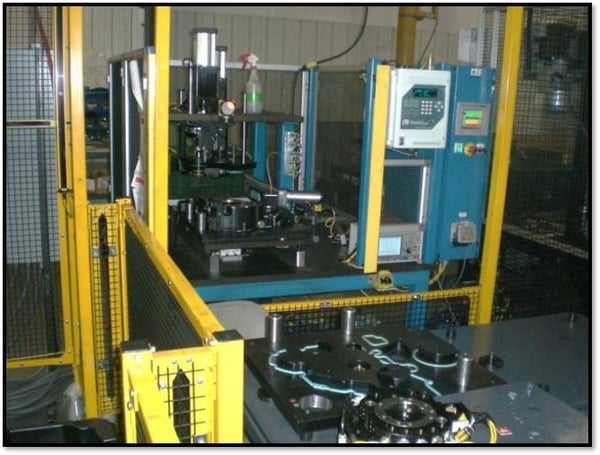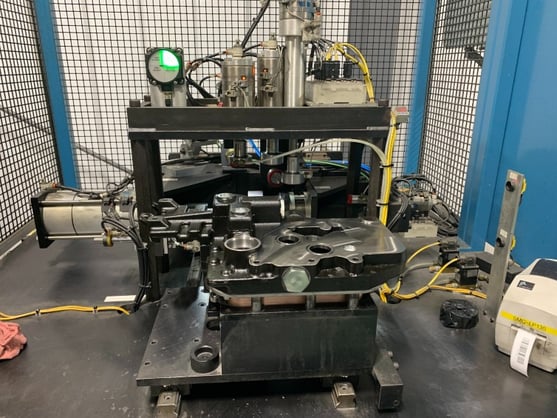You may have a great working knowledge of how custom CNC machining works:
Its smart use of technology and cutting-edge equipment and robotics.
Its engineers who help with design for manufacturing and design/fixture building.
Its programmed G-code and M-code, allowing for correct, repeatable part manufacturing.
Its incredible precision to meet strict spec tolerances.
But, do you know how to test a complex CNC part? After all, you need to know that all that hard work and advanced processes are doing their job and exceeding customer expectations. This article explores one important aspect of quality assurance: pressure testing.
There are 3 main ways to pressure test complex CNC parts:
- Air Decay
- Mass Flow
- Air Under Water
Pressure Testing: A Key Component of Quality Assurance
When you think about testing for quality CNC machining, your mind may jump to technologically advanced inspection tools, which are the foundation of a reputable CNC shop’s quality management system. CMM inspection, Millipore testing, hardness testing, roundness testing, surface finish testing, and more. These all go hand-in-hand with ISO 9001:2015 and IATF 16949:2016 certifications.
Yet, there are other methods specific to testing parts that hold pressurized fluids or gasses. Porosity, or a void found in the casting, can allow fluids or gasses to leak out of the part. Not only can this prevent a part from being pressure tight, hurting the part’s performance, it can cause internal corrosion or even surface defects.
A complex CNC machined part may be just one within a full assembly that includes a dozen or more parts all bolted together. It’s imperative that the manufacturer knows that verification has taken place to have confidence in the final product.
When to Pressure Test
Pressure testing can happen after machining, assembly, or vacuum impregnation, a process of sealing castings’ porosity and leak paths with a sealant under pressure to prevent fluids or gases from leaking.
When done after assembly (the most common point at which to pressure test), poka-yoke methodology determines if the assembly process was followed correctly, and the CNC machined part is acceptable. The upside is the entire assembly is verified by a pressure test.
Depending on customer requirements, testing may be as high as 100%, just to ensure it’s always a good part but, of course, that adds to production costs. Most often, a cost/value decision needs to be made while upholding product quality.

Types of Pressure Testing for Complex CNC Machine Parts
Air Decay
A pressure test control unit measures air pressure change within the part. Once the part is securely clamped into a fixture, pressurized air is introduced until filling up the part. Air pressure ranges from 5 psi up to 90 depending on pore size within the part, with 20-25 psi being the most common.
After around 30 seconds, and air molecules have stopped moving, a measure will be taken to determine how much the pressure drops and if that’s within the customer’s acceptable specs. The complexity of a part determines how long the test will take, up to several minutes if there’s more volume in that part and the customer requires it.
Real life examples include the air inlets or air intakes for engines, or an engine case in which oil will be loaded.
Mass Flow
Again, air around 20 psi range is introduced into the part. A gauge monitors the pressure, showing when the part is completely full and at 20 psi. At this point, when no more air can enter the part, the gauge reads zero. If any air escapes through pores, the gauge records that air is entering the part, revealing that there’s a leak.
Depending on the part and its performance requirement, zero doesn’t always have to be the goal. Often, a small leak rate, such as plus or minus 5 sccm (Standard Cubic Centimeters per Minute), can be acceptable for a part.
Air Under Water
A more “down and dirty” testing method — because it relies on visual observation, not a gauge — air under water is convenient and accurate, and completing it is simple. A part filled with air and with all openings sealed is lowered into a tank of water. Inspectors are looking for bubbles, small like champagne or big blurbs, coming up until reaching the water’s surface.
Because this test relies on visual inspection, lights underneath the water ensure everything can be seen.
.jpg?width=650&name=Photo%201%20(1).jpg)
What Gets Pressure Tested?
It all depends on the part. A bracket on a tractor? No need to. An engine component? Definitely! And, if it’s important enough to be tested initially, it’ll likely always be tested. The part is just that important.

Top-end CNC shops have integrated data matrix part marking systems within their processes. Once a part passes a test, a part number code is added so scanning and tracking that part is easy. Each part is traceable during every part of the process and, at any time in the future, a record can be pulled showing that part’s pressure testing scores, the station, the date, etc.
CNC shops need to adjust their pressure testing capabilities just as they adjust to production demand. If volume dictates new testing be added, the shop will.
Stecker Advantages Are Customer Advantages
Not every CNC machine shop has the ability to utilize every pressure testing method. They can either subcontract testing to another firm or add that capability. In the case of air under water testing, Stecker Machine needed to pressure test a large transmission housing, so an 8’X10’X6’ tank was constructed to handle that project’s testing needs. The part was so large (holding so much air) that steel weights had to be added to pull the part under water.
In the end, where and how testing happens may not be important. What is important is the bottom line: high-quality, complex CNC parts at a fair price. CNC machine shops that have internal pressure testing capabilities in-house can control the quality at every step. And not having to send parts out creates a shorter lead time.
Although most customers decide on what pressure test is needed (and what specs), an experienced and knowledgeable CNC machine shop may be asked by customers to share their opinion based on past projects.
As you’ve read, life is easier (and more efficient) when a CNC machine shop offers in-house capabilities that streamline processes. What other value-added services should you be aware of when evaluating a shop? Read our Value Added Services Checklist.







